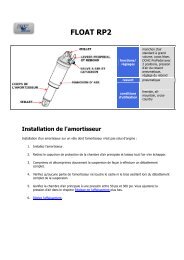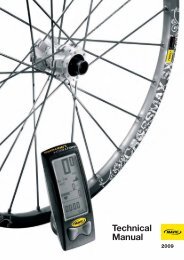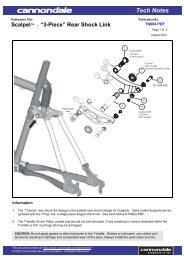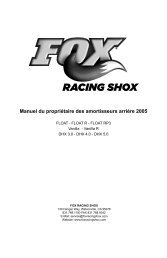Dlr2 & Sl Owner's Manual Supplement - lesrouleuxdewailly - Free
Dlr2 & Sl Owner's Manual Supplement - lesrouleuxdewailly - Free
Dlr2 & Sl Owner's Manual Supplement - lesrouleuxdewailly - Free
You also want an ePaper? Increase the reach of your titles
YUMPU automatically turns print PDFs into web optimized ePapers that Google loves.
Fork Boot<br />
The fork boot protects the internal parts<br />
(inner tube, races, lubricant, needle bearings,<br />
and other internal parts) from contamination<br />
and damage. It is a barrier to water, dirt,<br />
dust, mud, or grit encountered while riding.<br />
If the boot is loose or damaged; dirt, water,<br />
dust, salt spray or other contaminants will<br />
quickly ruin the fork.<br />
Always tighten the zip ties and clamps<br />
securely. Replacement boots, zip<br />
ties, and cable clamps are available<br />
through a Cannondale Dealer.<br />
If you find boot damage, the area under<br />
the boot should be professionally<br />
inspected for contamination or damage.<br />
The damaged boot must be replaced<br />
with a new one. Do not try to fix it.<br />
WARNING<br />
A<br />
CHECK THE BOOT BEFORE EACH RIDE.<br />
DON’T RIDE IF IT IS DAMAGED.<br />
REPLACE IT WHEN YOU FIND DAMAGE.<br />
Checks<br />
1. Check the boot for damage, cracking,<br />
splits, or tears. Be sure to check in<br />
the folds of the boot. Check for any<br />
cables or lines rubbing the boot.<br />
2. Check the attachment of the boot<br />
at the top and bottom. The upper<br />
and lower boot lips should be fitted<br />
over the lower collar and fork lip.<br />
NO PART OF THE FORK INNER TUBE<br />
(lower leg) SHOULD BE EXPOSED.<br />
3. Replace the zip ties and band clamps .<br />
Cleaning and Re-greasing The<br />
Telescope Under the Boot<br />
The fork inner tube and inner bearing races,<br />
parts of the telescopic fork assembly are<br />
located behind the fork boot.<br />
Wiping off old grease with a dry shop towel<br />
and re-apply a fresh heavy coating of grease<br />
helps assure that ,races and needle bearings<br />
remain well lubricated.<br />
Any clean high-quality bicycle bearing<br />
grease selected for riding temperatures and<br />
environment can be used. We assemble<br />
forks at our factory using Royal Purple Ultra<br />
Performance Grease NLGI #2 (ISO 46 BASE).<br />
1. Remove the front wheel.<br />
2. Release all fork air pressure.<br />
3. Carefully cut the upper and lower zip<br />
ties securing the fork boot. Some forks<br />
may have an screw type band clamp<br />
securing the upper portion of the boot.<br />
If this is the case, loosen the clamp.<br />
4. Lift the unsecured boot up to<br />
expose the inner tube (1).<br />
18








